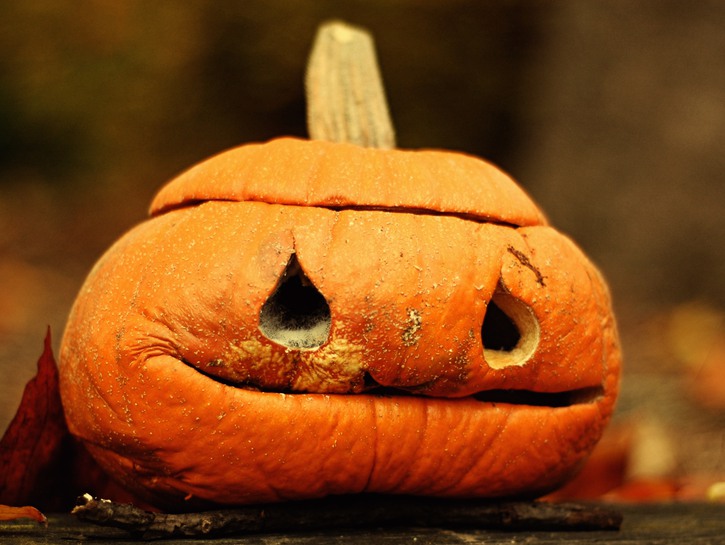Like all living things, once a pumpkin is cut from its lifeline stem, it descends into the Big Fade whose fate is certain death. An uncarved pumpkin’s thick skin protects its soft flesh for 3-6 months, depending on how dry its environment is. Conversely, carving a pumpkin expedites the gourd’s demise. But we don’t need it to live until next year’s Halloween; we only need to preserve our creations for a couple of weeks. To keep your pumpkins’ toothy grins intact, you want to protect the flesh, as much as possible, from moisture, mold, and bacteria. Here are some solutions to help our jack-o-lanterns cheat death until that ghoulish grim reaper comes knocking on the door begging.
How To Keep Pumpkins From Rotting
1. Bleach Bath

Like some many normal household products, bleach has a myriad of uses. It should come as no surprise, then, that bleach is the most effective way to keep jack-o-lanterns healthy the longest of all proposed methods in this article. Plus, it’s super easy and fun to watch the pumpkin float.
Materials:
- Jack-O-Lantern
- Bleach
- 1 clean 5-gallon bucket
- Big spoon (a stick will do, also) for stirring
- Paper towels or Newspaper
- Optional: dishwashing gloves

Method:
- Fill the bucket one-third of the way full with warm water
- Add about 3 teaspoons of bleach to the water in the bucket.
- Mix the solution.
- Immerse the pumpkin in the bleach solution. (The pumpkin will float so use your spoon or stick to push it around in the bleach solution, making sure all aspects have gotten a good soak for a full two minutes.)
- Remove the pumpkin from the bleach soaking solution. (This is where you may want to use your gloves.)
- Set on a bed of paper towels or newspaper to air dry.
- To clean up, just pour the solution down the toilet.
2. Silica Gel Packets
This is the perfect excuse to buy a new pair of boots for autumn: to reuse their silica gel packets. It turns out that this little packet is used to absorb excess moisture – every carved pumpkin’s nemesis. Although the beads themselves are non-toxic, some companies add chemicals to the packets which make them toxic. So, just to be safe, you might want to wear a pair of disposable plastic gloves when handling the product.

Materials:
- Silica Gel Packet. (If you have enough shoes in your closet which won’t warrant another pair, you can buy the beads here. Not nearly as much fun but good for your pumpkins.)
- Plastic Gloves
- Skewer or small knife
Method:
- With the skewer or knife, make a couple of little indentations into the gourd’s flesh.
- You will only need a couple of beads per pumpkin so there’s no need to slash it.
- Placing beads around the interior circumference will make sure the candle (or source of light) won’t’ wobble on top of the beads.
- With disposable gloves on, cut open the used gel packet. If using the store bought beads only, it’s still a good idea to use them.
- Gently embed the beads into your indentations.
3. Apply Petroleum Jelly

A pumpkin rots because it becomes dehydrated. Therefore, locking in the moisture helps maintain its lifespan. To accomplish this, another common household item can be used for an unforeseen practical purpose: petroleum jelly. Simply rub this all over the exposed areas of your carved pumpkin. The viscous substance creates a barrier between the pumpkin’s flesh and the air, protecting it from quickly dehydrating.
- Petroleum Jelly is flammable so do not use a candle if you utilize this method.
- For best results, swirl the pumpkin in the aforementioned bleach batch. This will ensure that all of the bacteria on the pumpkin will dissipate and not become trapped under the blanket of petroleum jelly
4. Daily Hydration Spray

Another way to keep your pumpkin looking fresh since the day you picked her, is to spray her daily with water. If you don’t have an empty one underneath your kitchen sink, you can find one at any dollar store. Plain old tap water is fine but, better than that, a diluted solution of bleach and water sprayed on your pumpkin a couple times a week will keep it hydrated AND stave off death-inducing bacteria.
5. Use Flameless Candles

Tea lights used to illuminate our jack-o-lanterns is a classic method. However, these innocuous little flames can harm your pumpkin because they are literally cooking the flesh. The flame draws oxygen from the pumpkin to feed itself thus increasing its rate of dehydration. Using flameless candles, or battery operated light sources fashioned to look like real candles, provides you the ambiance without harming your creation. Most variety, hardware, craft, and dollar stores will carry them, especially around Halloween.
6. Ice Bath

If you have used some or none of these proposed methods, it is still inevitable that your pumpkin will eventually rot. However, at the first sign of decomposition, try giving it a good ice bath overnight. The cold water is absorbed more quickly than room temperature water. Keeping it in water overnight ensures it a good long soak with ample time to absorb as much water as possible to stay hydrated.
You’ve spent a lot of time with kids patiently carving that thick flesh for these cool and haunting faces. Go the extra mile to make them last using any of these methods.
